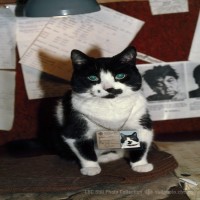Mark P: Life After ‘Webdreams’
 Starting in 2005 and running for three seasons, the IFC TV reality TV series Webdreams chronicled the lives of aspiring porn stars and adult entrepreneurs, including Mark P. Then and now, Mark was the programming whiz at 2much.net. His innovative streaming solutions pioneered ‘camming’ long before anyone had heard of it. Add the imaginative on-camera sets Mark provided to his models at his Montreal studio facilities, and 2Much.net was light years ahead of the competition.
Starting in 2005 and running for three seasons, the IFC TV reality TV series Webdreams chronicled the lives of aspiring porn stars and adult entrepreneurs, including Mark P. Then and now, Mark was the programming whiz at 2much.net. His innovative streaming solutions pioneered ‘camming’ long before anyone had heard of it. Add the imaginative on-camera sets Mark provided to his models at his Montreal studio facilities, and 2Much.net was light years ahead of the competition.
Much has changed since Webdreams signed off in 2008, but Mark is still in the video streaming trade.
“I’ve been the world’s biggest nerd my entire life,” he told YNOT. “I’m a programmer, webmaster, and network engineer. I’ve worn many hats over the years, many at the same time including programming team manager, solutions architect, studio manager, photographer and chief coffee maker.”
Mark’s interest in video streaming began in the 1990s, when he was surfing the still-young web for fun.
“When I first got online, I was downloading and collecting all kinds of content and started to notice that the best websites were using companies like ‘Adult Check’ and CCBill to charge for their services. I decided I wanted to learn how it worked. So, I made my first adult website and immediately began making money with it. I made a few more for myself, and then for some friends, and then turned that into a business.”
In the late 1990s Mark’s attention turned to what was being called ‘Live Porn’.
“I bought myself a webcam to learn how it worked, then hooked up with a few streaming companies including Python and another company whose name escapes me at the moment,” he explained. “My websites allowed users to download their software and video-chat with models and paid me a commission.”
As Mark’s commissions climbed, he realized he didn’t want to be a reseller anymore. Instead, Mark wanted to build, stream and sell his own content directly to adult consumers.
“But before I did that, I hired a programmer and together we hammered away at solving one issue after another until our first site went live,” Mark said. “I then decided I needed more programmers to do more things. By 2000, I had rented an office and had three programmers.”
Mark hadn’t intended to build a downtown Montreal studio with sets for his camming models, but the realities of early 21st century technology soon required it. “The software and streaming business was growing, but having the models work from home was proving too problematic,” he recalled. “Their hardware and/or bandwidth were too slow, and even worse, I had no control over the quality of the models themselves. Like any business, the models need to represent and reflect the brand of the company, and a certain level of quality control was required to maintain it. So, I decided to stop hiring work-at-home models and instead do everything in-house.”
The first2Much.net studio was in a residential loft in Old Montreal.
“To me it was cool because it had wood floors and rock walls but working there was very tough because there was no air conditioning and the roof leaked when it rained,” said Mark. “We had about eight or nine models working for us at the time but some models who came in for interviews were turned off by the location. One day during a rain storm the roof caved in and our place became flooded, and I decided enough was enough.”
The flood motivated Mark to move his camming studio a newer, drier commercial space.
“It was still loft-style which I loved, but much larger at 5000+ square feet and fully air conditioned,” he said. “I spent a lot of money to make it look great, and it worked. Now the models who were coming in to be interviewed were blown away at the location. My business was serious, and finally we looked serious: A cool look, multiple private studios, music pumping, programmers and techs buried in their work, a server room, lighting and camera rigs, you name it. One of the studios was decorated to look like a dungeon, while another had a sex swing. It was a great place!”
2Much.net’s cool new location led to the creation of Webdreams.
“As the company grew, we threw a few parties and were sure to invite reporters, which landed us in the news fairly often,” said Mark. “One day we received a phone call from representatives from Gala Film who were looking for ideas to base a reality show on. We invited them to come over, introduced them around. Before too long, we had signed agreements and camera crews following us all over the place here in Montreal, to Internext Las Vegas and Hollywood, Florida.”
Unfortunately, things fell apart for Mark, forcing him to sell off his studio and concentrate on creating improved video chat software. He puts the blame for the fall squarely on himself.
“I’m a dope and made some pretty bad decisions,” Mark said. “Business was growing and growing and my head grew along with it. A couple of scammers took advantage of my good nature. A programmer stole our source code and sold it to a competitor.”
“I didn’t handle either of these incidents properly and ended up spending more money on lawyers than was necessary,” Mark continued. “Then I hit taxation issues and made additional mistakes. I launched a lawsuit which took over four years and cost an unbelievable amount of money. I spent too much time and money on issues like that, and not enough time on what I should have been focusing on — and things started to slip away.”
The fact that Mark’s spouse was also his accountant only raised his stress level.
“She saw how much things were getting to me, and how things were slipping away,” he said. “Eventually, we decided to drop the lawsuit and scale back the business to save money. It worked for a short time, but we had lost our drive. We couldn’t seem to get the energy back into the business that we once had and realized that we didn’t really want it anymore anyway. So, we packed it all up.”
Well, not everything; Mark kept the video chat software part of his business going at 2Much.net. The latest version, Miricam v.5, allows adult sites to stream high quality full-screen webcam video and chat to an unlimited number of viewers, while charging customers any per-minute fees that they want to charge.
This is a long way from Mark’s first webcam software that “got something like 8 or 9 frames per second out of it at 320×240 resolution, and no sound,” he said, recounting some of the advances in streaming technology he has observed over the years.
“When Windows Media started to take off, we switched to it,” Mark continued. “We were able to achieve 24 to 30 frames per second with sound, but still at a small video size. It also suffered from incredibly long lag at something like 15 seconds. However, through tweaks, we were able to get the lag time down to about 5 or 6 seconds.”
“We then switched to Adobe Flash: We were able to push 640×480 video at 30 frames per second in real time. This was amazing quality at the time. But, of course, eventually Adobe Flash fell out of favour too. So, in 2015, our software was retired permanently and we built a brand new version from scratch — this time based on WebRTC, which lets us achieve HD, 2K and 4K Video, up to 60 frames per second, in real time.”
Since 2015, Mark has been crafting his video chat software at home. It’s a quiet life far removed from the parties at his Montreal studios and the celebrity he enjoyed through Webdreams.
“I miss trade shows!” he told YNOT. “I stopped going to most in 2015 too and stuck mostly to Qwebec Expo, but this year I hope to check out XBIZ Miami and AVN next January, which looks spectacular. I’m still in touch with some of the models I used to work with. All have moved on to ‘mainstream’ jobs but genuinely miss all the fun of the studio. I really believe we created a fantastic culture and atmosphere during our time in the limelight.”
This all said, Mark’s passion for adult video streaming, at a time when camming has come into its own, remains undimmed.
“I’m working on a new video chat platform that I think will be revolutionary,” he said. “I don’t want to share all of the details just yet, but I think people’s jaws will drop to the floor when they see what it can do. When it’s complete though I don’t have plans to sell copies of it but instead simply license the technology. I think it will be a game changer!”













